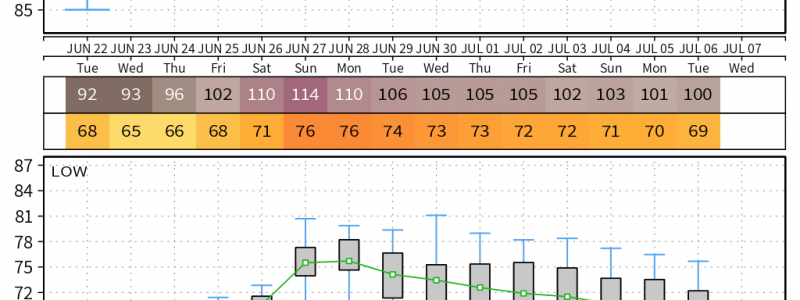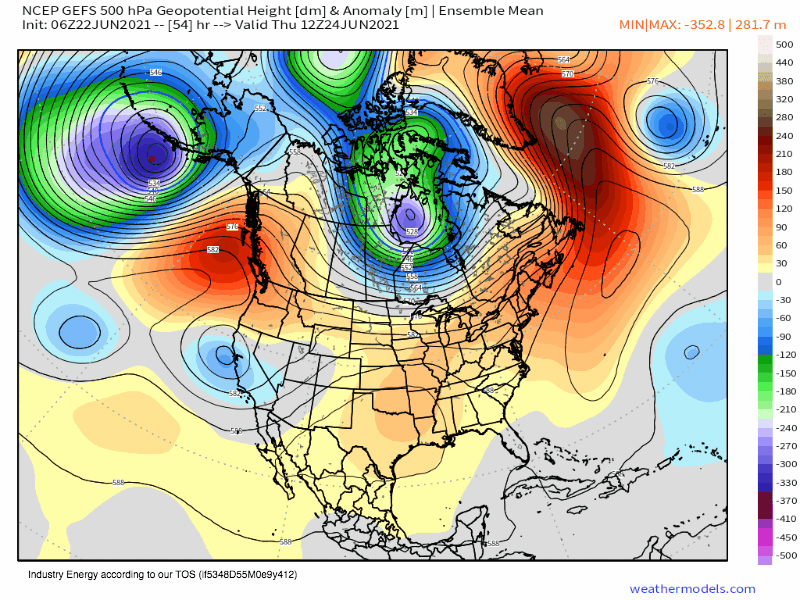
Western Heat Next Week Will Be Extreme. But to What Degree?
No pun intended.
As anybody who has read my blogs from last week knows, the West exists in a dire stage of historic drought. Dry season is deepening across the region, which means drought is encouraging heat to a level more extreme than the West has ever really known. This mostly happens when dry air and soil, which require less energy to heat up than if they were relatively moist, edge heat that would already be near-record even higher. Unfortunately, another acute chapter in this spiral of extreme summer weather is sliding into the medium range at the moment.
Summer across the interior northwest is always quite hot. Temperatures in the central valley of California, for example, typically approach or even exceed 90ºF as average daily highs this time of year. Further north, central Washington and Oregon see average highs in the low 80ºFs. This all means that, across this part of the West, there isn’t that much room for non-dangerous extreme heat. Even highs 5-20ºF above average, which is hardly a rare event under oppressive summertime ridges, can cause physical stress that may prove dangerous to the vulnerable. When truly anomalous, extreme events do occur, the danger can be severe.
An event like this appears possible from the central Californian valley north to central British Columbia from the weekend through next week. There is some degree of model support for heat that could challenge all-time records during this period, with weekly anomalies that call to mind some of the most extreme long-term temperature departures from the norm of recent memory (not quite as bad as this, but not too far from it either).
The synoptic scale setup is one apparently favorable for high-end heat, with a potent blocking pattern over the Atlantic leading to the kind of atmospheric contortion that supports a Pacific jet loop known as an ‘omega block’, due to the Ω shaped ridge that results. At the crest of this ridge over the Pacific Northwest, there is wide ensemble support for heights near the top end of climatology.
As a result of this ridging, massive amounts of sinking air will encourage clear skies, downsloping, and advection from the desert southwest. Amidst near-record dry soils, solar heating will promote a string of very hot days stretching from the weekend through the week.
But how hot, exactly? Will it be a ‘regular’ heatwave, dangerous but forgettable? Or something more?
Individual models like the GFS have, for a few days now, been presenting eye-boggling scenarios of unfathomable temperatures in parts of the West. A quick disclaimer: the following is individual model output, probably one of the most extreme I’ve ever shared, and should not be taken at face value without reading this entire blog.
If the above verified, it would be a record shattering heat wave that could prove catastrophic, especially to vulnerable populations.
The way I see it, there are two questions that must be asked to verify an outlandish model run: is it consistent with the way the atmosphere works, and is it consistent with other model data?
For the first question, the answer is… sort of. When contemplating “how the atmosphere works”, I really mean two things- the physical processes we learn about in school, and the climatology of the region in question. Let’s look at Redding, which the GFS above shows hitting a sweltering 124ºF on Sunday. The highest June temperature ever recorded in the city is 111ºF, the highest ever temperature 118ºF. Clearly, the data shown by the GFS is far so far above these long-standing records as to be climatologically fishy. That’s a strike against the solution shown above. On the other hand, though, the physical processes that support heat in the central CA valley- downsloping, subsidence, and solar radiation- all seem to be there. The first two will rev into overdrive at the hands of an unusual, anomalous midlevel omega ridge (which itself has wide support from every model I’ve checked). The third, meanwhile, will be basically the same as it always is on cloudless early summer days, but with the twist of low soil moisture, which allows dry near-surface air to partition more of the sun’s energy into heat. This all means the atmosphere will support heat to an almost unfathomable extent, a real ‘perfect storm’ of heat. That’s a check for extreme heat.
So far, we’ve found a reason to doubt record-smashing heat, and a reason to consider it. The next step is also easier- check other models!
Looking at the GEFS, which is the ensemble system that runs alongside the GFS, would be a good idea if we trusted the GFS’s ‘thought’ process but wanted alternative opinions; an assumption that atmospheric chaos is behind any opacity in the forecast. But that isn’t really the problem- for the GFS to be projecting these extreme temperatures incorrectly, something is probably wrong with the physics of the model itself. This issue would be carried over to the ensemble system. In the case of severe medical malpractice, we wouldn’t ask the same doctor for a second opinion; we may even fly over to Europe to visit a clinic there. That’s what we’ll do with this forecast- consult the trustworthy ole’ EPS, the European ensemble system.
When we look at the distribution of this (presumably better calibrated) ensemble system, a picture starts to emerge.
On consult with the EPS, we can see a competing idea for the weekend heat: a distribution clustered outside of record monthly temperatures but inside all-time record temperatures. This will be hot, and likely dangerous, but it won’t slaughter all time records. This idea checks all boxes: it fits climatology, the ‘perfect storm’ for heat that I’ve discussed earlier, and agrees reasonably with other models and with itself.
So, in conclusion. If you live in the northwest, don’t fall for sensationalized model imagery. Instead, find ways to stay cool, check in on elderly and otherwise vulnerable neighbors, hydrate sufficiently, and conserve electricity. Heat will be extreme, and it will worsen drought, and it will cause great physical stress to those not adequately prepared, but probably not quite like the GFS portrays.













